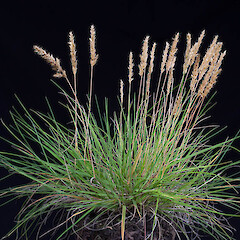Trisetum antarcticum
Synonyms
Aira antarctica G.Forst., Avena antarctica (G.Forst.) Roem. et Schult., Trisetum saxeticolum Cockayne et Allan
Family
Poaceae
Flora category
Vascular – Native
Endemic taxon
Yes
Endemic genus
No
Endemic family
No
Structural class
Grasses
NVS code
The National Vegetation Survey (NVS) Databank is a physical archive and electronic databank containing records of over 94,000 vegetation survey plots - including data from over 19,000 permanent plots. NVS maintains a standard set of species code abbreviations that correspond to standard scientific plant names from the Ngä Tipu o Aotearoa - New Zealand Plants database.
TRIANT
Chromosome number
2n = 28
Current conservation status
The conservation status of all known New Zealand vascular plant taxa at the rank of species and below were reassessed in 2017 using the New Zealand Threat Classification System (NZTCS) – more information about this can be found on the NZTCS website. This report includes a statistical summary and brief notes on changes since 2012 and replaces all previous NZTCS lists for vascular plants.
Please note, threat classifications are often suggested by authors when publications fall between NZTCS assessment periods – an interim threat classification status has not been assessed by the NZTCS panel.
- Conservation status of New Zealand indigenous vascular plants, 2017 . 2018. Peter J. de Lange, Jeremy R. Rolfe, John W. Barkla, Shannel P. Courtney, Paul D. Champion, Leon R. Perrie, Sarah M. Beadel, Kerry A. Ford, Ilse Breitwieser, Ines Schönberger, Rowan Hindmarsh-Walls, Peter B. Heenan and Kate Ladley. Department of Conservation. Source: NZTCS and licensed by DOC for reuse under the Creative Commons Attribution 4.0 International licence.
2017 | At Risk – Declining | Qualifiers: Sp
Previous conservation statuses
2012 | At Risk – Declining | Qualifiers: Sp
2009 | At Risk – Declining
2004 | Gradual Decline
Distribution
Endemic. North Island south from the southern Egmont Coast, on Kapiti Island and western and southern Wellington Coasts to Cape Palliser. In the South Island at Cape Farewell and along the outer Marlbrough Sounds and adjacent islands.
Habitat
Coastal, on gravel, sand and bluffs.
Detailed description
Densely tufted, dull green to grey-green grass up to 400 mm tall, with rather rigid leaves usually reaching or sometimes overtopping the dense spike-like panicles. Branching extravaginal at plant base, sometimes intravaginal above. Leaf-sheath to 40 mm, very minutely pubescent or with extremely minute appressed hairs between ribs. Ligule 0.2–0.6 mm, truncate , erose often sparsely minutely ciliate, undersides sometimes minutely prickle-toothed. Leaf-blade 35–220 × 1.5–4 mm, flat or inrolled, undersides mostly smooth, often scabrid near the long-narrow tapering apex; upper surface ribbed with sparse to dense minute hairs and prickle-teeth on ribs, hairs slightly longer near ligule; margins minutely prickle-toothed. Culm 40–300 mm long, internodes glabrous, occasionally bearing a few minute prickle-teeth below panicle. Panicle 20–150 × 6–25 mm, compact, oblong, very dense, rarely with some lower branches and pedicels smooth or with sparse minute prickle-teeth or rarely minute hairs. Spikelets 4.5–7.0 mm, greyish green or brownish amber. Glumes unequal, hyaline, keel thickened with sparse long prickle-teeth on upper ½; lower ⅔–⅘ length of upper, linear-lanceolate, upper slightly < spikelet, elliptic; margins with prickle-teeth near acuminate to almost mucronate apex. Lemma 4.0–6.2 mm, bidentate to shortly bicuspid, papillose, prickle-toothed above and on keel; awn 3.5–6.0, initially straight becoming recurved, insertion in upper ¼ of lemma. Palea with minute prickle-teeth on keels and usually on margins. Callus hairs to 0.5 mm. Rachilla hairs to 2.5 mm. Lodicules c. 1 mm, glabrous. Anthers 1.0–1.7 mm. Ovary 0.8 mm; stigma-styles to 1.3 mm. Seed 2.5–3.0 × 0.6 mm.
Manaaki Whenua Online Interactive Key
Similar taxa
Distinguished from the nine other indigenous species by the dense, compact, oblong panicle (rarely with spreading lower branches) and by the stiff, rigidly erect, flat grey-green to dull green leaves with the undersides glabrous and the upper minutely, though distinctly scabrid.
Flowering
November–February
Fruiting
December–May
Propagation technique
Easy from fresh seed and the division of whole plants. An attractive grass for an open spot in well drained soil. Once established rather drought tolerant.
Threats
Still quite common in parts of its range but there has been a range contraction around Wellington due to the spread of weeds into its habitat, and also because of greywacke quarrying along the south coast.
Etymology
trisetum: Three-bristled
antarcticum: Antarctic
Where To Buy
Not commercially available
Attribution
Description modified from Edgar and Connor (2000).
References and further reading
Edgar E, Connor HE. 2000. Flora of New Zealand. Vol. V. Grasses. Manaaki Whenua Press, Christchurch, NZ. 650 p.









